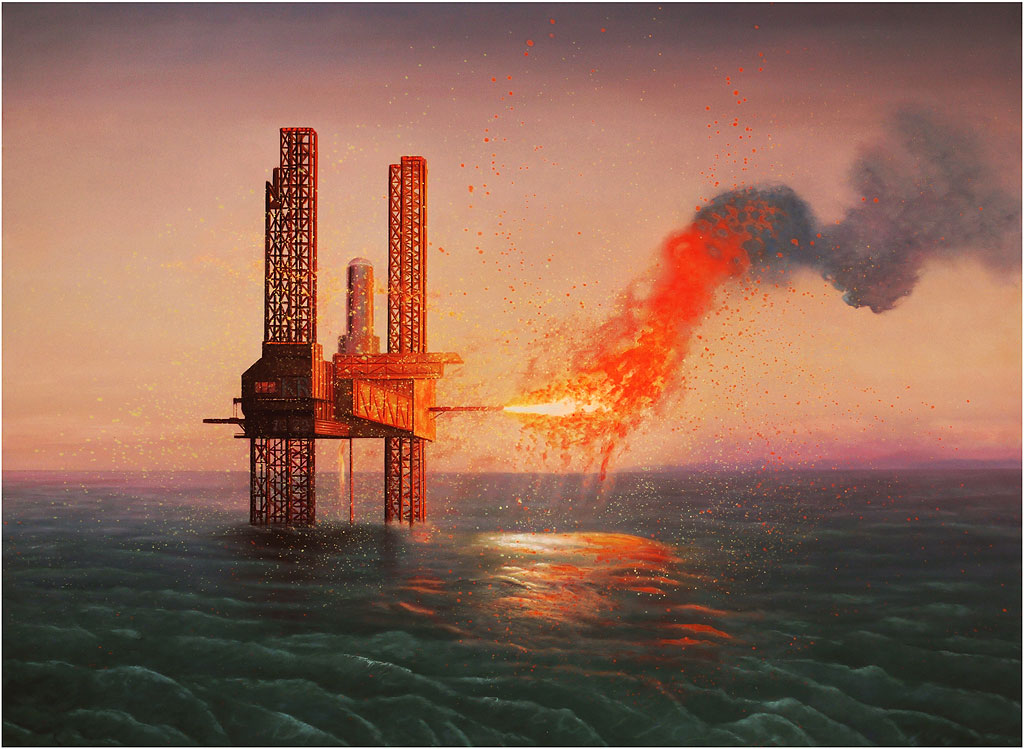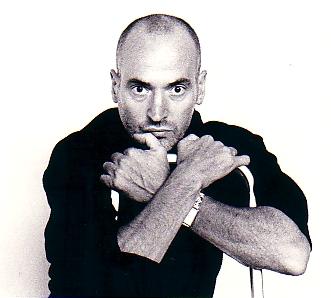Klaus Ritterbusch
Larger paintings from the thematic group
"Turmzimmer in Babel"

The last harbor piece without embarkation
[text]
"The last harbor piece without embarkation" refers in the title and the so called 'curtain-composition' to the harbor pieces of Claude Lorrain, but simultaneously takes a particular view from the basin of Duisburg on.
180 x 280 cm, oil on canvas, 1991 (Collection Gelsenwasser AG)

Disaster of the limping sharks
[text]
"Disaster of the limping sharks". With the somewhat sarcastic alliteration of the title, the tragic futility of the German submarine-war is countered. This war is shown here by a motif from La Rochelle at the french Atlantic coast.
"Ritterbuschs artworks illustrate picturesquely the inescapable inversion of human hubris. They pose the finiteness against the clearest light and the impetuous faith in the future." Anne Rossenbach
190 x 280 cm, oil on canvas, 1990-91 (Former long-term loan for the lobby of the Ministry of Economics / North-Rhine-Westphalia)

The Last Supper
[text]
"The Last Supper" is the larger parallel-image of the "disaster".The gates of the Submarine hangar refer roughly to the window composition in Leonardo's Milanese mural painting, which helps this painting to its title.
"The 1991 dated 'Supper' is mapped in 2006 with a 'blank space' in the right middle panel, which today fills a small statue with a helmet, obviously a French Adrian helmet as it was carried in World War I by French troops. In order for this small, surreal inserted war memorial, to the spatial-atmospheric blurring is also added a blurring in time. Because this submarine hangar comes clearly from the second world brand. " Thomas Schleper
140 x 415 cm, oil on canvas, 1991

The siege
[text]
"The siege" has a startling resemblance to the scenery of 11.9. 2001 in NY, but it was already painted in 1995/6 and showed at Aachen in 2000.
The burning building is inspired from the Prudential-Building in Warsaw, long time Europe's highest building, which showed in the days of the Warsaw Uprising a similar smoke cloud. As so often in the Turmzimmer, we find here without purpose a double historical charging.
190 x 280 cm, oil on canvas, 1995/6

Energies of the south pole
[text]
"Energies of the south pole" forms the main work of the since 1987 edited cycle "Battle for the poles", which consists of extensive series of smaller oil paintings and works on paper.
Whether the landscape depicted is still covered with ice remains unclear, but not the exploitation and utilization of even the most inhospitable places of the planet.
190 x 280 cm, oil on canvas, 1990

In the beginning the word did not occur
[text]
The title "In the beginning the word did not occur" could pose a philosophical question, if one would refer it to the relatively short history of the primates.
Despite all revealed dynamics of meteoric processes it seems a more pastoral landscape motif, which does not exactly belong to the context of the Turmzimmer, where it is rather spoken about the power and destructiveness of mankind.
190 x 280 cm, oil on canvas, 1990

The invention of Christianity
[text]
"The invention of Christianity". Main work of the 'Ruedersdorf-cycle', which consists in a series of oil paintings and paintings on canvas-fotos.
"Klaus Ritterbusch discovered the cement plant Z II in Ruedersdorf 1995 and photographed the more or less dangerous and collapsing ruins. The factory, technically advanced in the Third Reich, was designed by the famous industrial architects Fritz Schupp and Martin Kremmer. In GDR times degenerated the system, among others pegged out the air filter. On the entire plant a thick layer of lime enlarged on, which acted as a fertilizer, so that the whole plant was covered by a bright green carpet of moss. In 1996, the ruins were demolished. " Daniel Stemmrich
220 x 280 cm, oil on canvas, 1995-97

The breakthrough
[text]
"The breakthrough". Represents one of the three production halls of the Otto Schickert-Werke in Bad Lauterberg, where top secretly hydrogen peroxide was made for the V2 rocket engine. The near Odertalsperre saved the high electric power requirements.
Since the military purpose was unknown not only to most residents, but also to the Allies, the investment of bombing was spared, the here visible collapses are due to natural decay. 1945 all technical units were brought to Great Britain.
The hall could still be seen in 1991 by the artist, 2 years later the final demolition began.
188 x 280 cm, oil on canvas, 1992 (Collection LWL Industrial Museum Dortmund)

La Poubelle
[text]
"La Poubelle" shows the collection bunker of the incinerator in Duesseldorf-Flingern.
This painting was shown in many thematic exhibitions, so it made for example in the five centuries extensive show “The Second Creation - Images of the industrial world” in Berlin's Gropius-Building, the metric largest final image.
" 'La Poubelle' as a mindless, escapist space of the 21st century society, which has soared to God? Definitely a fascinating work of art, and my current favorite painting in the Art Museum Gelsenkirchen. " Michael Schulz
280 x 360 cm, oil and acrylic on canvas, 1991/2 (permanent loan from the RWE AG in the Art Museum Gelsenkirchen)

Orakel 300 C
[text]
"Oracle 300 C" was a painting ordered by the Babcock AG: a fictitious technical tube in which takes place a mysterious welding action.
Opposite the cold perfection of the stainless steel, the figures form a counterpoint, but also seem lost and helpless in a strange way.
The '300 C' in the title indicates the color name of the shimmering blue tone in the background.
215 x 280 cm, oil on canvas, 2001 (Collection Thyssen Marine, Kiel)

Fortissimo
[text]
"Fortissimo" is the unreal emptied former turbine hall of the power station Peenemuende, the laboratory of the missile program until 1945. The title refers simultaneously to the current use of the space as a concert hall for the Usedom Music Festival.
"Can be found in the sense of classical enlightenment a light metaphor in the environment of the hall, or is it mysteriously a hostile space? The image of the transparent bell as the only installation in the hall whose purpose can not be clarified and should not."
Philipp Aumann
"A shock-like energy incident, the blind and potentially blinding light storm that the sun penetrates from the outside, floating the building. It outshines the lattice shape of the windows and fades the pattern of bare floor tiles: Glimmering answer to the transparency of glass and steel, with which the modern architects in those days and in the following time worldwide exposed themselves? " Thomas Schleper
190 x 280 cm, oil on canvas, 2016 (Collection Historical Technical Museum Peenemuende)

Standard Buried Collector
[text]
The "Standard Buried Collector" is architecturally quite real one special underground functional area in the Duesseldorf sewage system, that Ritterbusch has visited several times since 1990, but by the color design it is something entirely different, which is perhaps more reminiscent of a strange necropolis or even of Fort Knox.
The title takes a technical term of the bipolar semiconductor technology, but also points to the 'collector,' which means the reservoir of heavy rain located next door.
From this motif exist other minor variations, along with numerous oil paintings and pastels from the waste water system, in 1991 the one man show "In the Empire of Shadows " at the Duesseldorf City Museum took place.
190 x 280 cm, oil on canvas, 2017

Machappella
[text]
"Machappella". One imagines a sort of a high technology front in a mysterious room. With two occurrences of almost all picture-elements, once again doubled by the reflection, this represents the aspect of digitalization. The title is a neologism of 'macchina' and 'cappella', in which the first syllable is relating to Ernst Mach and the of name of a supercomputer.
The machine as a 'demiurge' - in the course of Artificial Intelligence it is no longer quite a strange idea.
190 x 280 cm, oil on canvas, 2017/8 (Collection LWL Westfälisches Museum für Industriekultur)

Peak Oil
[text]
"Peak Oil" could be seen as a furious climax of the age of oil. The horizontal, phallic-martial looking gas-flaring has been taken over by a real oil platform, the other units are composed of different systems.
The first 'peak-oil-theory' dated already from the fifties, but after 2000, with a new version of C.J. Campbell, it gained thousands of followers, especially at the North American east-coast, who emanated from a complete standstill of all transportation of goods by the drying up of all oil sources, and therefore exaggerated self-sufficiency.
The real historical development was different from that theory, which gives this pyromaniac painting also an ironic undertone.
140 x 280 cm, oil and fluorescent pigment on canvas, 2018/9

Peak Oil II
[text]
"Peak Oil" could be seen as a furious climax of the age of oil. The horizontal, phallic-martial looking gas-flaring has been taken over by a real oil platform, the other units are composed of different systems.
The first 'peak-oil-theory' dated already from the fifties, but after 2000, with a new version of C.J. Campbell, it gained thousands of followers, especially at the North American east-coast, who emanated from a complete standstill of all transportation of goods by the drying up of all oil sources, and therefore exaggerated self-sufficiency.
The real historical development was different from that theory, which gives this pyromaniac painting also an ironic undertone.
140 x 190 cm, oil on canvas, 2021/22

The big bubble
[text]
"The big bubble". Seems to be a perfect room in a skyscraper that could be located in London, because of the implied 'Gherkin' silhouette. On the column, the Aramaic letters from the Rembrandt painting "Belshazzar” were added graffiti-like. This legendary painting can also be seen in London, in the National Gallery.
The substantive link between these two aspects is left to the viewer, it might oscillate between irony and tragedy.
180 X280 cm, oil and fluorescent pigment on canvas, 2019

Synapse II
[text]
'Synapse II' forms a second version of the same topic after the half-sized portrait format 'Data Center', also from 2020.
Intensive red tones of indicated diodes dramatize and exaggerate billions of unspectclular, while invisible data transfers.
The hightechnology of such a scenary has apparently not yet entered the domain of painting, because the ever growing dominance of this access to the world is in inverse proportion to its plausible, comprehensibly visualizability.
With 'Synpse II' the attempt is made to overcome this discrepancy in a duochrome, bipolar strong impression.
190 cm x 280 cm, mixed media on canvas, 2020
Links to further work:
www.punzmann-contemp.com
www.galerie-kk.de(Tronien und Masken)
klimatische-eruptionen.klausritterbusch.de(Klimatische Eruptionen)
Links to further information:
www.Bilder-der-Arbeit.de(Industrieveduten)
Klaus-Ritterbusch - Kataloge, Bildbände und Textpublikationen

IMPRESSUM
Klaus Ritterbusch
Diese E-Mail-Adresse ist gegen Spam-Bots geschützt und wird deshalb nur mit aktiviertem Javascript angezeigt!
Inhaltlich Verantwortlicher gemäß; § 10 Absatz 3 MDStV:
Klaus Ritterbusch
Umsatzsteuer-Identifikationsnummer gemäß; § 27 a Umsatzsteuergesetz:
103/5184/0693
Datenschutz


